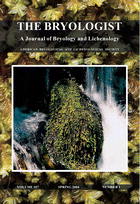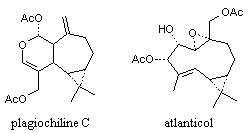
Dr DAVID S. RYCROFT
School of ChemistryJoseph Black Building
University of Glasgow
GLASGOW G12 8QQ
Telephone 0141 330 4479 Fax 0141 330 4888
Email David.Rycroft@glasgow.ac.uk
![[Photo of DSR]](misc/dsr.jpg)

|
Dr DAVID S. RYCROFTSchool of ChemistryJoseph Black Building University of Glasgow GLASGOW G12 8QQ Telephone 0141 330 4479 Fax 0141 330 4888 |
![[Photo of DSR]](misc/dsr.jpg) |
Areas of interest |
![[Link to photographs of liverworts]](photos/glencoe_w.jpg)
| ||||
Liverwort chemistry and chemosystematicsLiverworts grow prolifically in Scotland, especially in the west.Oil bodies generally assumed to contain terpenoid and/or aromatic compounds are produced within the cells of liverworts, and a wide variety of terpenoid skeletal types has been found,including some which are unique to liverworts. |
![[Link to oil bodies]](photos/oil_bodies_w.jpg)
| ||||
| We have developed an NMR profiling method based on direct extraction of plant material with the NMR solvent CDCl3. Complementary NMR and GC-MS experiments (with Dr Cole) using the same solutions have enabled us to identify characteristic compounds in several species that are available in small quantities only and to compare gatherings of the same species from different parts of the world, in some cases using herbarium material over eighty years old. | |||||
| In collaboration with groups in Germany, we have investigated the systematics of the large and morphologically difficult genus Plagiochila. Secondary metabolites revealed by NMR profiling prompted morphological and phytochemical investigation of disjunct populations (in North America, the Neotropics and Europe with Macaronesia) and resulted in the discovery of important range extensions, for example of Plagiochila retrorsa Gottsche and Plagiochila papillifolia Steph. | |||||
![[J. Bryology cover - elaters]](misc/j_br_cov_w.jpg) |
SEM of elaters from the sporophyte of the Neotropical liverwort Plagiochila retrorsa, now known from Madeira and the Azores as well as the USA (where it was known as P. sharpii H.L.Blomq.), Costa Rica and Mexico. | SEM of the papillose leaf surface of Plagiochila papillifolia, now known from the Azores as well as the Neotropics. | ![[J. Bryology cover - cells]](misc/j_br_cov_cells_ww.jpg) |
 |
In the case of Plagiochila atlantica F.Rose, a European endemic, atlanticol and plagiochiline C have served as chemical pointers to a systematic relationship with Neotropical species notable for the presence of leaf surface waxes, supported by the subsequent discovery of leaf surface waxes in P. atlantica itself. The more recent synomymization of P. atlantica with the Neotropical P. heterophylla by Heinrichs was confirmed through phylogenetic reconstruction based on analysis of DNA sequence variation. |  |
Further information |